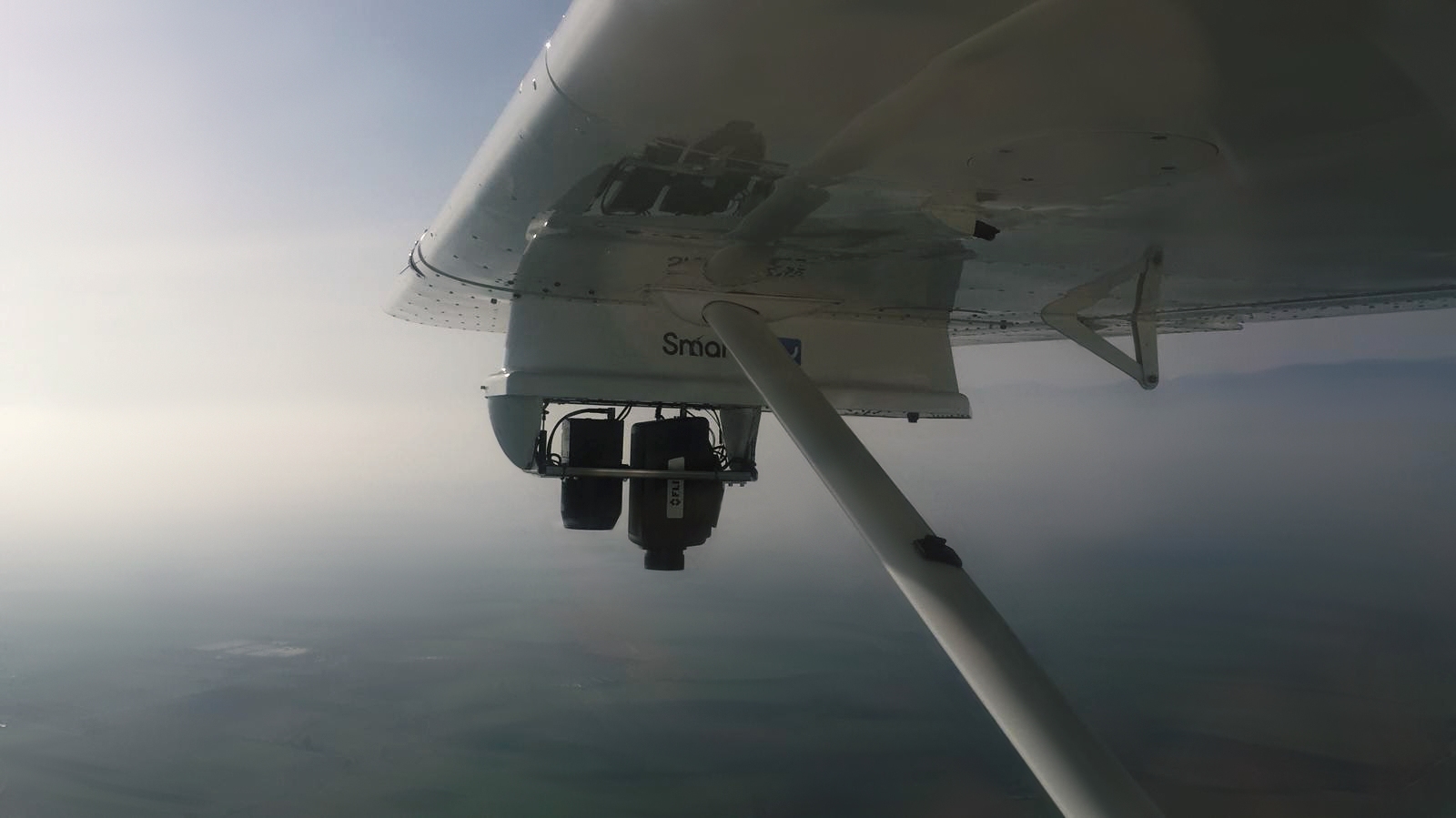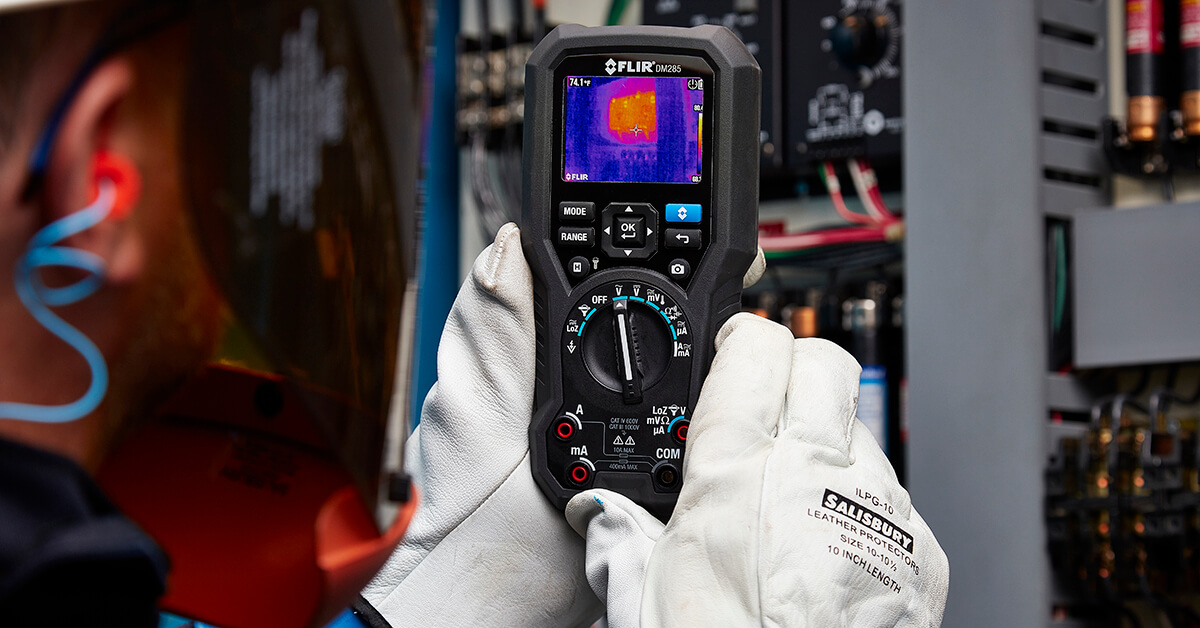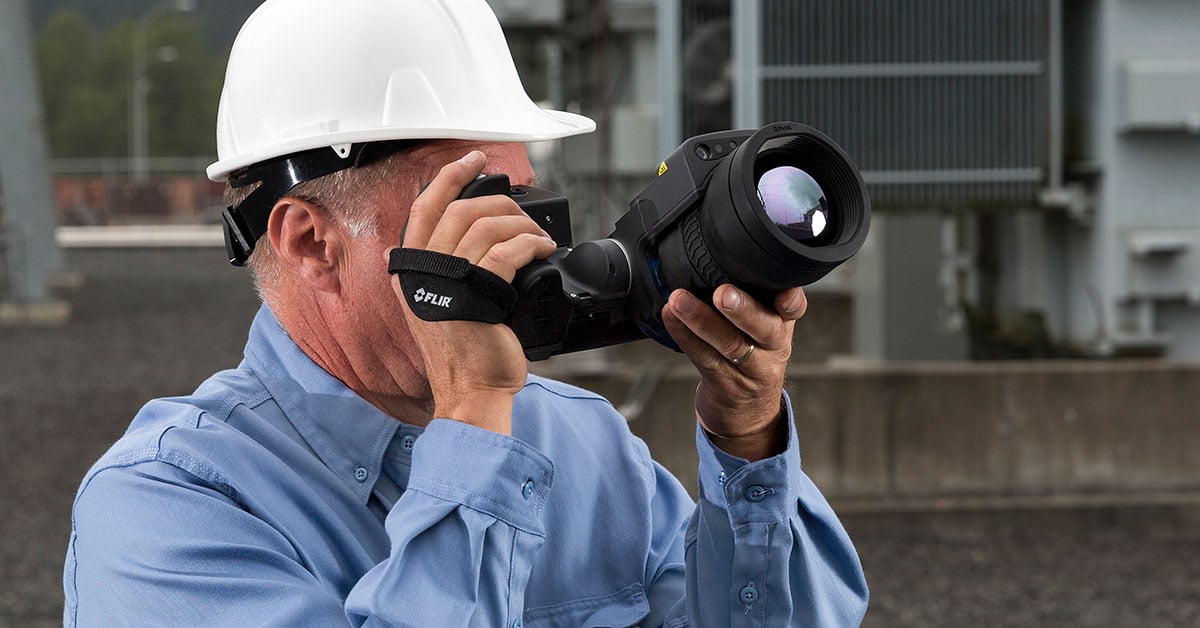Infrared Thermography Inspection for Extending Asset Lifetime and Keeping Shutdowns Under Control
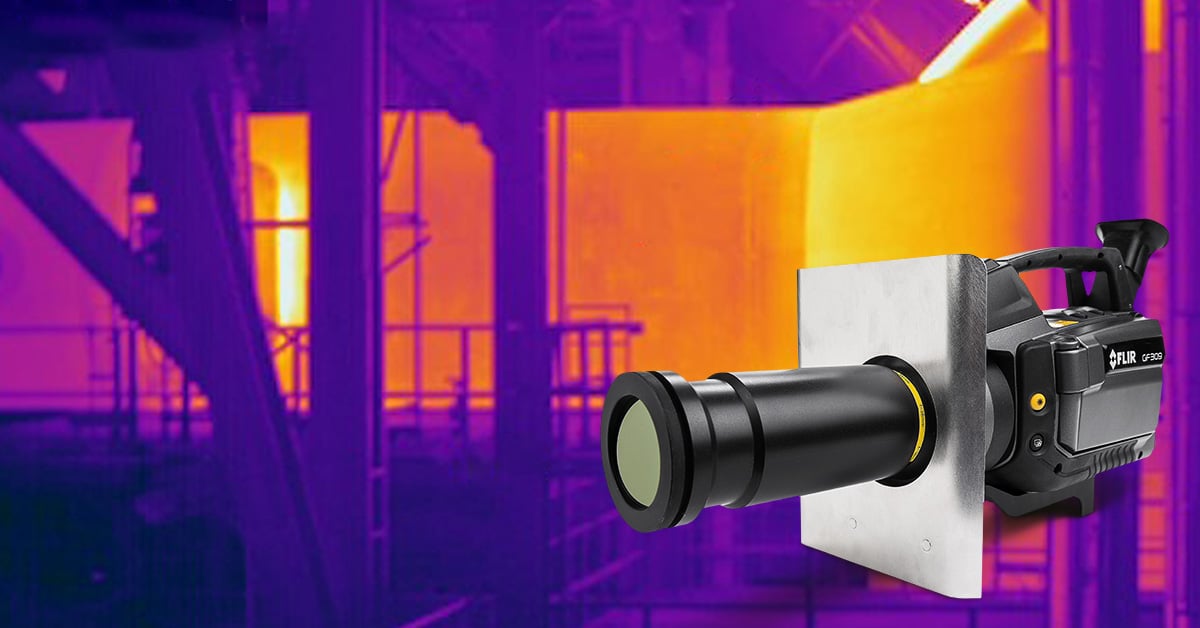
FLIR GF309 - An innovative solution to diagnose potential trouble areas of refractory lined equipment and online monitoring of radiant tubes in process heaters.
IR thermography is a form of nondestructive testing that measures temperature variances of a component as heat (i.e., thermal radiation) flows through, from, or to that component. Thermographic inspection of industrial units and processes is a new direction in the diagnosis (non-destructive testing) and operation of industrial objects, allows you to remotely visualize and accurately obtain objective information about the object and the state of its internal and external systems. Thermography is a non-contact method of monitoring allows early detection of various defects and faults at an early stage of their occurrence.
Besides renewable energy, crude oil remains one of the world’s most important raw materials. Complex and costly refining processes turn it into petrol, diesel, and other hydrocarbons. Refining is a complex dish; but a few ingredients matter more than others. Everything is like salt, pepper, and spices. A common challenge plant refinery operators face is tracking changes to their plants over time. In refining, it’s important for plant operators to identify changes to the plant and its assets that could indicate the development of defects so they can fix these issues before they get worse. Infrared thermography has vast and varied uses in the petrochemical refinery. Over the past two decades, many refineries have depended on the use of infrared thermography as a nondestructive means to assist in their condition monitoring and predictive maintenance programs. By mapping temperature levels and variances of a component it is useful to detect any hot spots where equipment may weaken or fail. It is advantageous over traditional visual inspection and other tools because infrared technology does not have to be in contact with the equipment being monitored. Various applications where temperature analysis of equipment required are critical. Some of the major uses of infrared thermography include detecting refractory damage in processing equipment, checking for coke deposits in process heater tubes, monitoring temperature of reformer radiant tubes, inspecting rotating equipment, electrical distribution systems, testing of sulfur lines, steam, and product lines, and determining sludge and product levels in storage tanks.
THE TECHNOLOGY
FLIR GF309 is designed for high temperature industrial furnace applications. These infrared cameras are ideal for monitoring all types of furnaces, heaters, and boilers, particularly in the chemical, petrochemical, and utility industries. Custom-built to see through flames, the FLIR GF309 also features a detachable heat shield designed to reflect heat away from the camera and camera operator, providing increased protection.
WHAT PROBLEMS GOT SOLVED WITH THIS TECHNOLOGY
We utilize infrared thermography to detect abnormal or unexpected thermal patterns that may cause equipment failure (i.e., “invisible” threats). Thermographic imaging analysis is used to diagnose problem areas and determine their impact and severity. It also enables us to pinpoint abnormal temperatures and resolve variances and deficiencies.
Assessment of Refractory and Ceramic Blanket Condition Inside Refractory Lined Equipment, Boilers and Fired Heaters
Historically the condition of the refractory lining had been determined by refiners by visual inspection at each of planned shutdowns of the plant that occur every four years. This was an entirely reactive inspection regime. Refractory breakdown, which is the loss of the insulating layer, consisting of high-temperature resistant materials, directly inside the exterior metal of refractory lined equipment, is a common problem that requires special attention as this metal will suffer degradation if exposed directly to the temperatures present inside. Infrared thermography is effectively used to detect abnormal heat patterns on various assets, indicating inefficiency and defects.
Some of the Major Findings With This Technology That Lead to Significant Decisions to Avoid Failures
Refractory or ceramic blankets inside, refractory lined equipment, boiler, heater shell, or stack get dislodged due to spalling and other issues, causing an increase in the heater casing temperature at various locations. These high temperature zones are captured in infrared images as hot spots. Infrared thermography can be used to monitor the extent of refractory damage. From an energy efficiency point of view, these types of applications are most useful.
Rotary Kiln at Coke Calcination Unit, lined with refractory bricks on its internal shell, during operation observed with falling bricks, damaging refractory casting of Tertiary air nozzle, and firing Burner hood. The petroleum green coke is fed into a refractory lined rotary kiln where the volatiles are driven off during the calcining process in an oxygen deficient atmosphere. Air can be injected through the kiln shell to burn a portion of the volatile matter in the kiln providing usable heat to the kiln.
After the incident of bricks falling continuously through hot dump area and coke cooler badly blocked with mud and carried over bricks, series of thermography assessment were performed to help gauge the extent of anticipated repair in Rotary Kiln. It was noticed that the damaged section has increased which may be inferred from the images on right side. We found that the previously documented hotspots had greatly expanded. Where before there were only isolated hot spots, now showing signs of widespread refractory failure. It appeared as large number of bricks were now missing throughout circumference of Rotary Kiln allowing greater heat transfer to the outer shell of the equipment.
During unplanned outage, the damage areas observed were perfectly matching with those indicated by thermograms taken in-service.
Regularly scheduled infrared inspections helped us to detect and document the areas to pinpoint possible failure points before they become severe enough to affect operations.
As shown by the some of the several examples from the field illustrating real applications, using thermography as part of the preventive and predictive maintenance program on refractory lined equipment has significant benefits.
Infrared Thermography for Identifying Symmetry and Temperature Variation Concerns
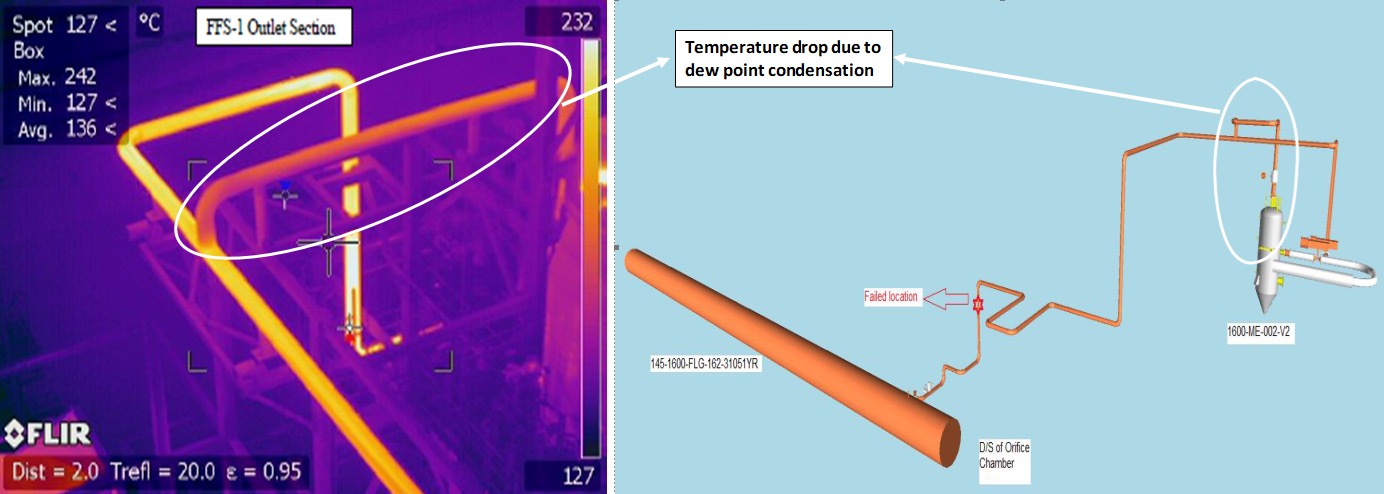
Thermograms helped to identify symmetry and temperature variation concerns in the Fin-Fan cooler and Flue Gas Piping
Residue fluid catalytic cracking at ADNOC Refining is the world’s largest in terms of capacity and has state-of-art technology for the Reactor-Regenerator system. RFCC is used for upgrading heavy feedstocks to light products such as gasoline. During shutdown, for all inspection and maintenance activities on this humongous equipment, which loaded with many cyclones at intricate locations, are extremely difficult to access considering the quantum of scaffolding erection involved. RFCC is a business-critical unit, and each hour of a shutdown counts.
Radiant Tube Skin Temperature Monitoring
Process heaters are a critical component in the refining of crude oil. Temperature is a determining factor in the safety and performance of process heaters. Inaccurate or unreliable temperature measurement will eventually lead to a host of issues – all of which reduce efficiency, take up plant operators’ time, and hurt the bottom line. For these reasons, refinery should rely on reliable temperature measurement solution to monitor radiant. Poor temperature measurement and monitoring could result in the tube temperature exceeding the tube’s metallurgical limit. At certain point, the tube will fail. When that happens, the hydrocarbon is released into the fire heater, leading to catastrophic results. Often, infrared thermography is utilized after load changes to establish that the process heater is continuing to operate normally.
Fewer numbers of viewing ports and sight areas obtained through the ports often pose limitations to image coverage. The viewing angle, change of firing rate, and burner changes during transient phases of operation also pose difficulties in capturing images. Imaging should be done in close liaison with the operations people.
By utilizing a thermography imaging device specifically designed for heater inspections, valuable performance information is obtained to monitor the overall temperature profile of the process heater tubes. Skin temperature indication by thermocouple provides information about the heater tubes only where the thermocouple is welded. Infrared imaging gives information about the entire heating surface of the tubes. In the hands of a knowledgeable engineering team, accurate infrared data can be utilized to significantly increase heater throughput while helping to ensure safe operation of the heater.
Proper maintenance of fired heater and tubes can be enhanced with a properly designed and implemented infrared scanning regime. To reap the maximum benefits of the infrared scanning program, the overall process must itself be reviewed on a routine basis and modifications applied as better understanding of the specific dynamics of each heater is understood.
CONCLUSION
As with all businesses, refineries must keep downtime to a minimum and avoid unnecessarily extended shutdowns. Most materials that refineries use to complete turnarounds are custom fabricated and not available without months of advance notice. Costs could multiply greatly if materials needed at time of shutdown are not present.
For more information about thermal imaging cameras or this application, please visit: www.FLIR.com/gf309
ABOUT AUTHORS

Asharaf Ahmed serves his current role in ADNOC Refining as Team Leader, Inspection (Non-Destructive Testing) for all its operating sites. He achieved ASNT NDT Level III in Eight Methods-Infrared Thermography, Ultrasonic Testing, Eddy Current Testing, Magnetic Flux Leakage, Visual & Optical Testing, Radiography Testing, Magnetic Particle Testing, and Liquid Penetrant Testing. He holds a master’s degree-MBA in Marketing, and a bachelor’s degree in mechanical engineering. He has 27 plus years of experience (upstream and downstream) in leading NDT activities in processing plants, NDT project services organizations on energy and construction projects in the Middle East, and West Africa. As an accomplished leader, his proven track record and in-depth experience positioned strongly to lead the NDT Division transformation through continuous improvement in all ADNOC Refining sites.
ADNOC is a leading diversified energy and petrochemicals group wholly owned by the Emirate of Abu Dhabi. ADNOC Refining, a joint venture company between ADNOC, Eni, and OMV, is among the largest and most sophisticated on earth, located about 240 km West of Abu Dhabi City in Ruwais Industrial Area of United Arab Emirates. Embraced with a strong commitment to safety and operational excellence, the company operates in highly regulated environments where effective asset integrity management is crucial for ensuring the safety, reliability, and compliance of their production facilities. With various blocks and critical process units, it works like a beating heart; operating day and night to convert the Emirate’s vast hydrocarbon reserves into the essential high quality refining products, serving diverse industries that energize economic activity at home and abroad.

T P Singh is working with Teledyne FLIR, as Senior Sales Director for Emerging Countries, which include, India, Middle East, Sub Sahara Africa, Turkey and CIS countries. Mr. Singh has a professional work experience of 28 years in field of Energy, Oil & Gas, Manufacturing and Security sector. He has written many technical write ups on different Thermal Imaging camera applications.
His academic qualification includes Engineering Degree in Electronics & Telecommunication, Business Management course from Indian Institute of Management, Calcutta, & Digital Marketing Course from DMI, Ireland.

